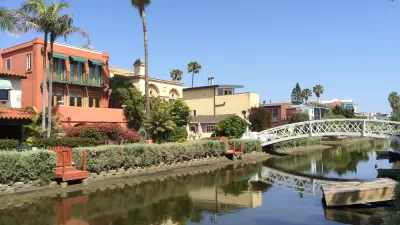A Los Angeles Times editorial argues that Skid Row’s future should learn from the mistakes of the past.

There’s a wrinkle included in the proposed community plan for Downtown Los Angeles (DTLA 2040) that has provoked concern from observers, including an editorial from the Los Angeles Times.
The wrinkle in question is a zoning district in the city’s Skid Row that would only allow affordable housing development. The blocks between between 5th and 7th streets and San Pedro Street and Central Avenue would be zoned as IX1, a new zone allowing for “mixed industrial use.” According to the Los Angeles Time Editorial Board, the new zone will create “the first area of the city with new housing reserved for residents defined as acutely low income (homeless or almost) to moderately low income.”
As noted in the editorial, however, the state of Skid Row in 2023 is a result of a 1970s approach to homelessness that concentrated services in this one section of the city near Downtown.
“In the 1970s the city adopted an official policy of ‘containment’ — concentrating cheap hotels, shelters and service agencies on skid row to both take care of residents and prevent them from setting up in other parts of downtown or the city. It was born of a desire by leaders to help and also to wipe their hands of the misery there,” explains the editorial.
Skeptics of the new zoning code point out the similarities between the new plan with the containment of previous decades. The editorial, however, calls for a new future for Skid Row—one that allows both affordable housing and market-rate housing.
The editorial, linked below, proposes a solution that would require higher portions of affordable housing, or a cap on market rate development in the area. “The goal in this particularly impoverished community is to make room for more housing and more investment to lift up the neighborhood. Making skid row more of a mixed-income community need not displace current residents or services, if done carefully,” according to the editorial.
FULL STORY: Editorial: Let skid row have affordable and market-rate housing. It’s the forward-looking thing to do

Maui's Vacation Rental Debate Turns Ugly
Verbal attacks, misinformation campaigns and fistfights plague a high-stakes debate to convert thousands of vacation rentals into long-term housing.

Planetizen Federal Action Tracker
A weekly monitor of how Trump’s orders and actions are impacting planners and planning in America.

Chicago’s Ghost Rails
Just beneath the surface of the modern city lie the remnants of its expansive early 20th-century streetcar system.

Bend, Oregon Zoning Reforms Prioritize Small-Scale Housing
The city altered its zoning code to allow multi-family housing and eliminated parking mandates citywide.

Amtrak Cutting Jobs, Funding to High-Speed Rail
The agency plans to cut 10 percent of its workforce and has confirmed it will not fund new high-speed rail projects.

LA Denies Basic Services to Unhoused Residents
The city has repeatedly failed to respond to requests for trash pickup at encampment sites, and eliminated a program that provided mobile showers and toilets.
Urban Design for Planners 1: Software Tools
This six-course series explores essential urban design concepts using open source software and equips planners with the tools they need to participate fully in the urban design process.
Planning for Universal Design
Learn the tools for implementing Universal Design in planning regulations.
planning NEXT
Appalachian Highlands Housing Partners
Mpact (founded as Rail~Volution)
City of Camden Redevelopment Agency
City of Astoria
City of Portland
City of Laramie




























